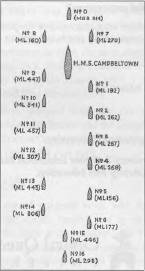- Author
- Evans, P.
- Subjects
- WWII operations
- Tags
-
- RAN Ships
- None noted.
- Publication
- March 1999 edition of the Naval Historical Review (all rights reserved)
The estuary of the Loire river, on which the town of St Nazaire is situated, was obstructed with shoals and mud-banks, many of which were dry at low tide. To avoid using the main channel, which could be easily protected, it was decided to cross the estuary at high water. To achieve this it was necessary to reduce the draft of Campbeltown from 14 feet aft to 10½ feet aft by removing as much weight as possible. The opportunity was taken to alter her silhouette to resemble a German torpedo boat, though this was not the principal reason for the alterations. In addition the `explosive factor’ was installed. This consisted of 24 depth-charges, with delayed fuse settings, `hidden in a special compartment on top of the fuel tanks’. ((Storming St Nazaire, James G. Dorrian, Leo Cooper, London 1998, Page 43. )) These amatol filled depth-charges were the only explosive devices carried in Campbeltown.
The return trip of 900 miles at an average of 11½ knots was well beyond the 600 mile range of Fairmiles. To facilitate this, two additional 500 gallon fuel tanks were fitted to the deck. They were coated with a self-sealing compound and covered with splinter mats. The high octane aviation fuel in these tanks to be used first and the tanks then filled with seawater to nullify the effect of explosive bullets igniting the gas that had replaced the liquid fuel.
Additional Oerlikons replaced the 3 pounder on the Fairmiles to assist against attacks by enemy aircraft.
The ‘Force’ was assembled in the port of Falmouth and after intensive training was ready to undertake the operation by 26 March. This would bring them to the target a little ahead of the optimum dates of 29/30 March, at spring high tides, for crossing the shoals and mud flats in the Loire estuary. If this period were missed on account of unsuitable weather, there would be insufficient darkness until the autumn.
Two ‘Hunt’ class destroyers HMS Atherstone and HMS Tyndale were assigned to escort the force to the entrance of the Loire, await their return, and provide escort home. As a further means of reducing Campbeltown’s draft, she carried only sufficient fuel for the one-way voyage. If the operation was aborted after the half-way point, she could not return under her own steam.
Towards the Bay of Biscay Tyndale spotted a U-boat and attacked. The submarine escaped. This caused considerable anxiety, however it was later learnt that the U-boat reported sighting `two destroyers steering south-west’ and no further attention was drawn to the convoy.
The Naval Force Commander was Commander R.E.D. Ryder RN, ((From 1934 to 1937 `Red’ Ryder, as he was known in the Royal Navy, was in command of the 3 masted schooner Penola which took an expedition to British Grahamland in the Antarctic. For this he was awarded the Polar Medal. Prior to that he had sailed a 30 ton ketch, with a crew of five naval officers from China to England. (Reference [London] Daily Mail, 30 March 1942.))) the naval contingent was 353, excluding the crews of the two escorting destroyers. The Military Force Commander was Lieutenant-Colonel A.C. Newman with 277 troops. In all a force of 630. Ryder and Newman travelled in Atherstone, then transferred to MGB 314 prior to entering the Loire River. All but around 80 troops in Campbeltown (Lieutenant Commander S.H. Beattie RN) were carried in the Fairmiles.

At 2200 HM submarine Sturgeon, acting as ‘marker’ was sighted and ‘the force formed up into the special cruising order which had been designed for the assault’ (see diagram on page 7).
The command ship, MGB 314 and MLs 270 and 160 formed the spearhead of the force and provided a screen for Campbeltown. They carried torpedoes, but not commandos, and were to clear the way of any patrol craft, guard ships, E-boats or U-boats. On reaching St Nazaire they would provide covering fire ahead of Campbeltown.
A diversionary attack by 70 Wellington bombers, forty minutes before the assault, was calculated to distract the German gunnery and radar, and drown out the noise of the 17 Fairmiles and MTB 74 with their high powered petrol engines.
